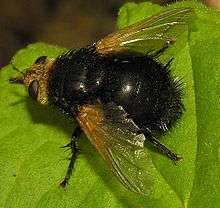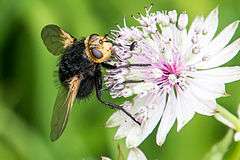Tachina grossa
| Tachina grossa | |
|---|---|
 | |
| Scientific classification | |
| Kingdom: | Animalia |
| Phylum: | Arthropoda |
| Class: | Insecta |
| Order: | Diptera |
| Family: | Tachinidae |
| Genus: | Tachina |
| Subgenus: | Tachina |
| Species: | T. grossa |
| Binomial name | |
| Tachina grossa (Linnaeus, 1758) | |
| Synonyms | |
Tachina grossa or giant tachinid fly is a very large tachinid fly found throughout most of Western Europe. At 15–19 millimetres (0.6–0.7 in) it is one of the largest species of fly throughout much of its range and is the largest tachinid in Europe. It is very distinctive, being hairy and with a black thorax and abdomen, and a bright yellow head.

Like most tachinid flies, the female lays her eggs on other living insect larva, the fly larvae then develop inside the living host, devouring it and eventually killing it. Its main hosts are the large hairy Lepidopteran caterpillars, particularly the Oak eggar moth Lasiocampa quercus and Macrothylacia rubi.
In the UK there is usually only one generation per year, though in southern Europe there may be two generations per summer season, though this has not yet been verified. The adult flight period is from July to August. Habitat is dry open meadows, peat land, and heaths.